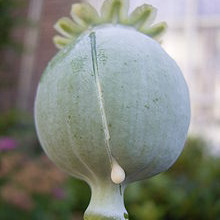This week, reports suggest that the 2013 opium harvest in Central and South Asia was the largest on record. But what is opium? Here's your quick fire science with Kate Lamble and Simon Bishop.
In this episode

00:00 - What is opium?
What is opium?
This week, reports suggest that the 2013 opium harvest in Central and South Asia was the largest on record. But what is opium? Here's your quick fire science with Kate Lamble and Simon Bishop.
Opium is dried extract from unripe opium  poppy seed pods. Depending on the plant variety, the latex may contain from 19 to 91% alkaloids - that's chemicals including the painkillers morphine and codeine.
poppy seed pods. Depending on the plant variety, the latex may contain from 19 to 91% alkaloids - that's chemicals including the painkillers morphine and codeine.
Although a small chemical modification can convert morphine to heroin, opiates in general have been used for centuries as medicinal painkillers and anaesthetics.
Opium spread across European and Asian empires between the 10th and 13th centuries, but its use is recorded even earlier than that -- the Ebers Papyrus, an Egyptian medical text, prescribes opium to calm noisy children!
The British traded both silver and opium from India to China in return for silk and tea. But in 1838, with opium addiction on the rise and demand for silver declining, the Chinese stopped all trade.
This led to two wars. In the end, China reluctantly signed treaties with the French and British allowing trade to continue and opening up Chinese ports to Western influence.
Morphine for use in medicine was first isolated from opium in 1804, and named after Morpheus, the Greek god of dreams.
When receptors in the brain and spinal cord are activated by endorphins, pain neurons cannot fire. Morphine takes the place of endorphins to have the same effect.
But it's not just poppies that make morphine -- we can too. Human white blood cells can release morphine into the blood to act as a hormone on neighbouring cells.
Opium-based anaesthetics have many side effects, including sickness and confusion, so modern surgery usually uses non-opioid chemicals. Morphine is still commonly used as a painkiller.
Because opium can be used in recreational drugs, opiate drug screens are common. In 1990, a veteran police officer in the United States, who had never broken any laws, failed one of these tests, when all he'd done was eat 4 poppy seed bagels.
However, poppy seeds contain anywhere from 4 to 200 milligrams of morphine per kilogram -- so you would need to eat a lot of seeds to feel any effect.
- Previous Come together
- Next Why can I squirt a jet of saliva from my mouth?









Comments
Add a comment